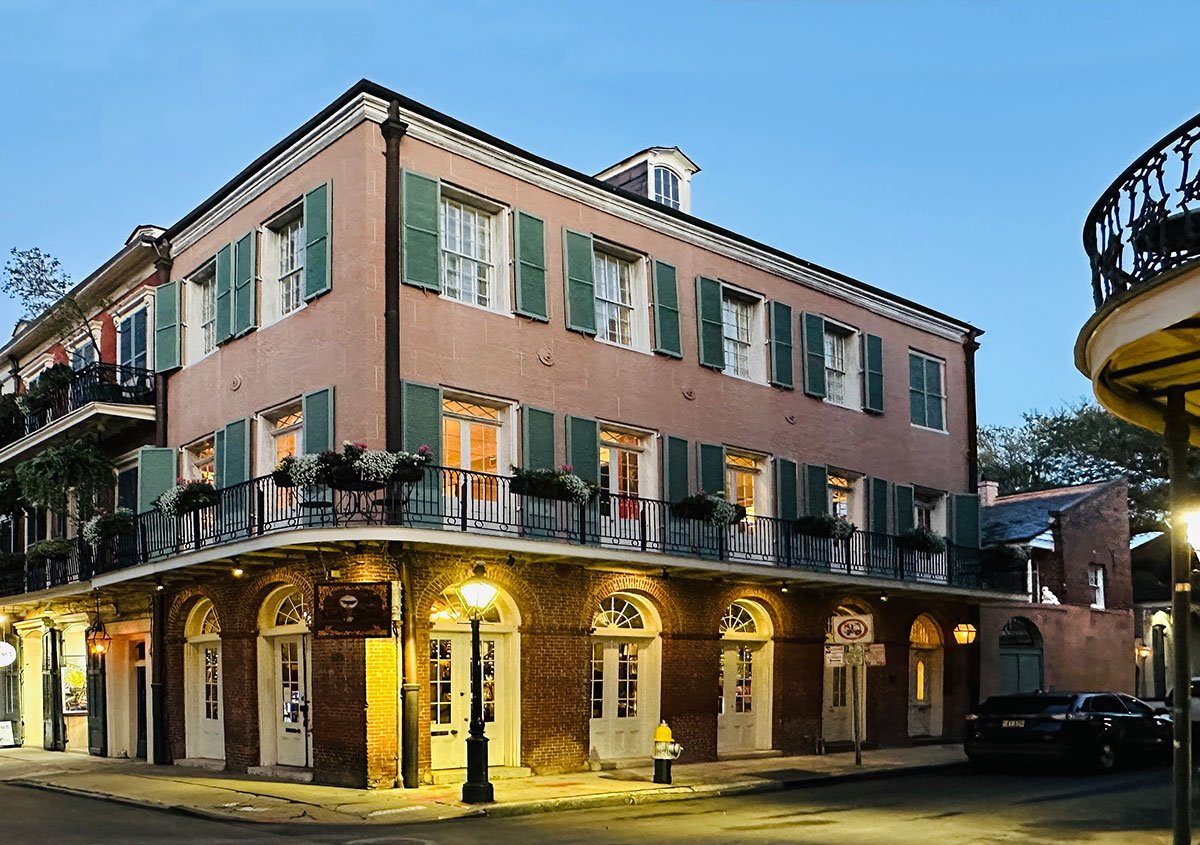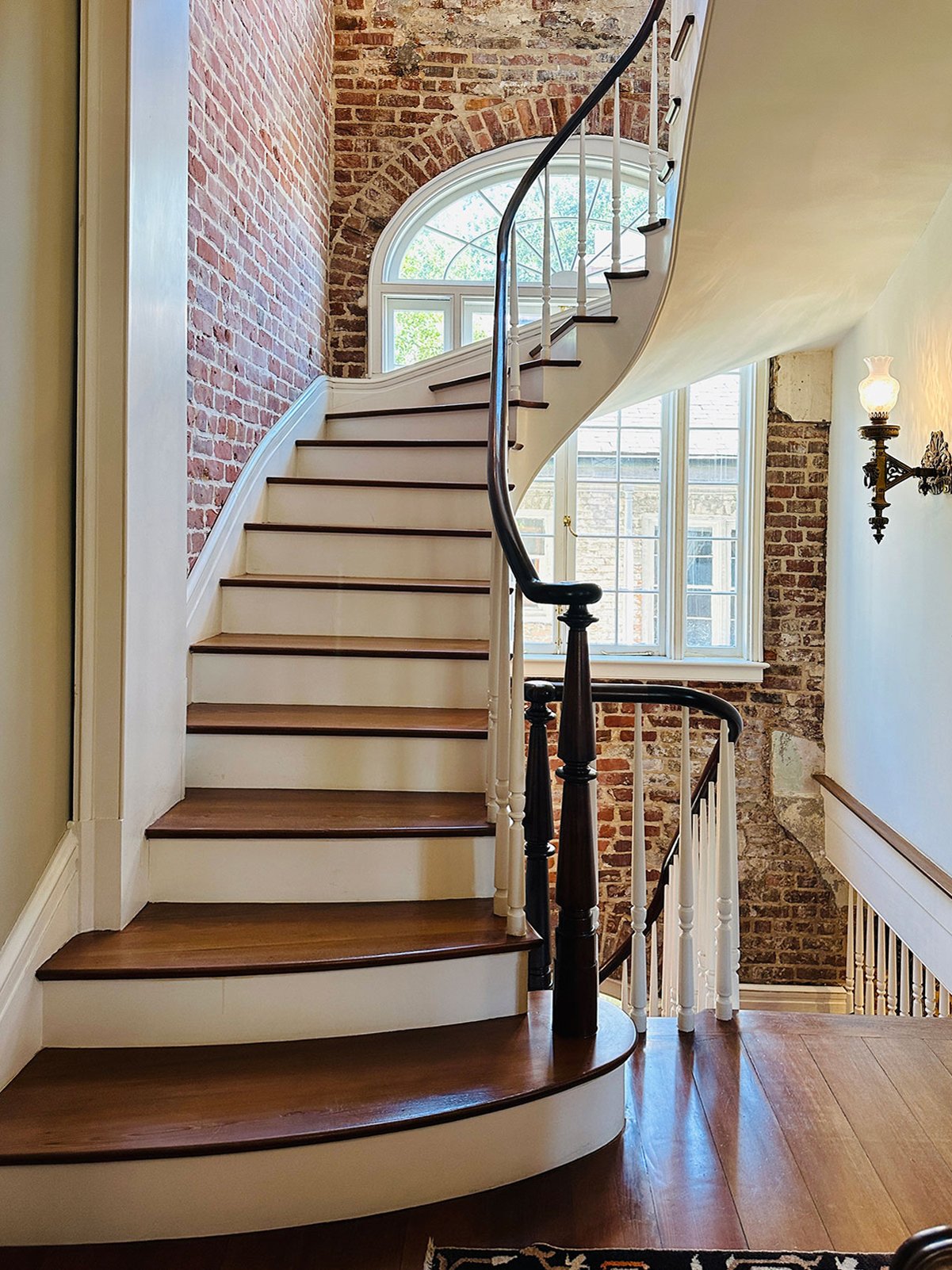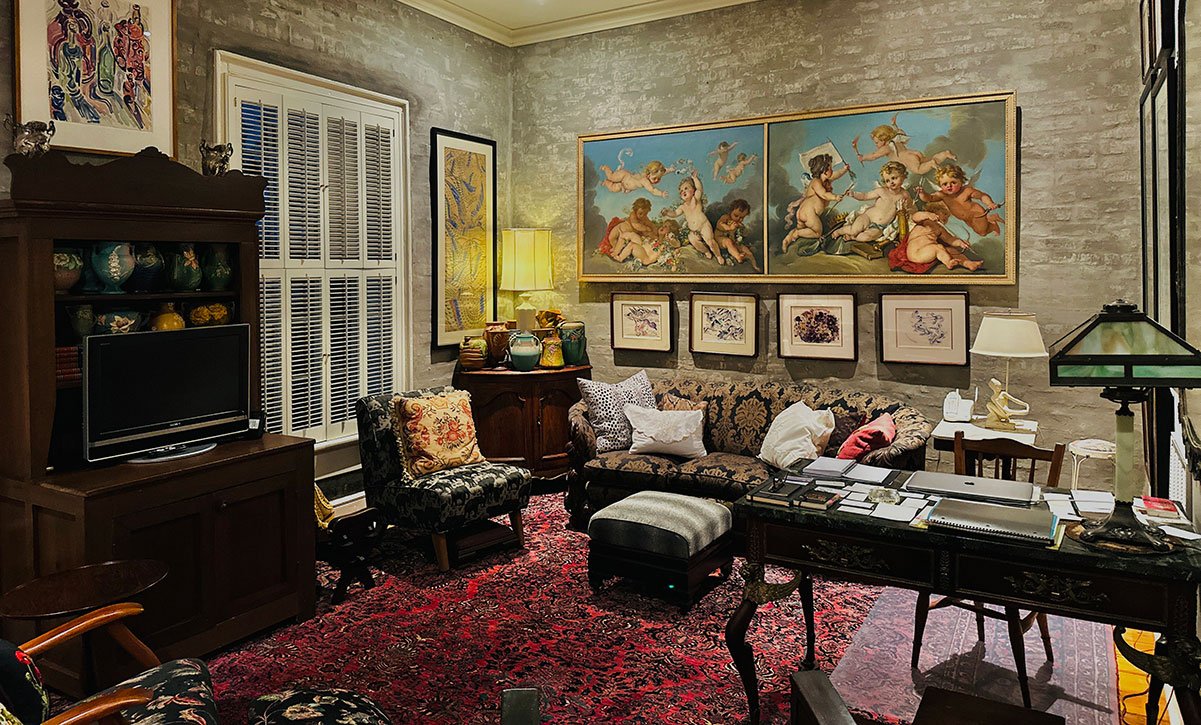The Gradual Seduction of Cucullu Row
The Chartres Street home of Scott Shows, part of Cucullu Row, built in 1828
February 2025A visionary young doctor purchases a derelict historic building in 1996 and spends the next decade transforming it into one of the most stately homes in the French Quarter.
– by Karen Hinton
photos by Ellis AndersonWhen Scott Shows first opened the door to his Chartres Street home in 1996, startled doves flew up from the main entrance and then out of the roofless, dilapidated building.
Shows smiled at the memory.
“As bad a shape as the house was in,when I saw the doves fly, I knew everything would turn out great,” he said.
Just a stone’s throw from Jackson Square, it is one of the townhouses built in 1828 known as Cucullu Row, the oldest intact row in the historic French Quarter.
Shows’ connection with the neighborhood began at an early age. Growing up in Columbia, Mississippi – just two hours from New Orleans – he often visited the French Quarter with his parents as a child.
“My parents jokingly said they took my brother and me to Galatoire’s Restaurant to teach us good manners. No elbows on the table! So many visual sensations reside in my memories as well; the cottages with shutters, the buildings, the streets, the people in the streets. That’s a lot for a kid from rural Mississippi,” said Shows.
Following his studies at Millsaps College in Jackson, Mississippi, Shows attended the University of Mississippi Medical Center. After he bought the derelict property in the Quarter, Shows worked as a doctor in Mississippi, traveling back and forth to New Orleans, settling full time in the city in 2004.
The plaque for Cucullu Row, on the corner of Chartres and Dumaine
1865 rendering, Diboll Collection, THNOC
When Shows bought his home, he knew New Orleans would be his hometown for the rest of his life, but he did not know how historic his property was when he signed the deed.
Cucullu Row extends from Dumaine to Madison streets on Chartres Street and is named after one of its owners, Simon Cucullu, a Spanish merchant and ship owner.
It’s likely that Jean-Baptiste Le Moyne de Bienville, the founder of New Orleans, pitched a tent on or near Show’s land in 1718 when he and French troops arrived. It was the only dry and elevated land near the sharp, crescent bend of the Mississippi River.
Vieux Carré Library, Cucullu Row in 1975
French scientist and engineer Pierre Baron was the first owner of the entire Cucullu Row site, where he built a home, as well as an observatory to view the stars at the corner of Dumaine and Chartres streets. His celestial observatory was the first one constructed in the Americas and with his telescope, he gave New Orleans its first taste of the scientific discovery known as the Enlightenment.
Unfortunately, the brutal humidity of New Orleans wreaked havoc on the porous bricks — often made of mud — used in the brick-between-post construction of the time. Later, it’d be recommended that the bricks be covered with boards or plaster. Baron had left his bricks and timbers uncovered and unprotected, and they crumpled after several decades.
The 1728 observatory was replaced by a market, one that was later destroyed in the great French Quarter fire of 1788. Then in 1828 – almost exactly 100 years after Baron built his home – New Orleans architects Louis Lemoine and James Lambert designed the three-story row houses, which were built for Simon Cucullu and his family.
When Scott began the restoration process in 2001, he sought out architect Peter Trapolin of Trapolin Peer, who’d been highly recommended. His overarching goal was to “do right by the house and the French Quarter.”
Shows house in 1943, courtesy the Vieux Carré Library
“I was very naive and had no idea what I was getting into,” he says, laughing. “I had a tiger by the tail.”
The three-year process involved working with the Vieux Carré Commission (VCC), the organization tasked with overseeing the historic integrity of French Quarter buildings.
“I know to some people, the VCC is the antiChrist,” Shows continues. “But if they didn’t want me to do something, I didn’t do it.”
One major project concerned the real wall of the main house - the original arch to the courtyard had been bricked over, leaving no access between the areas. With permission from the VCC, the original entrance was restored.
These entrances from the main house to the courtyard had been walled over.
The courtyard added so much to the enjoyment of the house, Shows resisted filling it with air-conditioning equipment. Instead, he installed a geothermal system. The system is passive, saves energy and most of the equipment is underground. Although his was only the second system to be installed in the French Quarter, Shows’ father had installed one in his Mississippi office and been thrilled with it, giving the homeowner the confidence to proceed.
Shows allowed some of the bricks and posts to peek through the walls of his home to showcase the original brick-between-post construction from the 1700s.
“Panels covered the bricks when I bought my home,” said Shows. “We took down the panels. To protect the bricks, we used the exact type of mortar [to repair the work]. I wanted the bricks to live, not die. It was important to me to preserve as much of the house as possible.”
The stairway crafted by Zuccarello Custom Woodworkers
Demonstrating his commitment to preserving and capturing the past, Shows rented an apartment for a month in the French Quarter to house his staircase builders, the Zuccarello brothers, owners of the Zuccarello Custom Woodworkers in St. Francisville, Louisiana. They are considered one of the finest masters of stairs in the country and are known for their replications of circular stairs from the 1800s.
“They built some of the work in St. Francisville, but other parts of the stairs had to be built in place. I hired them because I wanted it done just right, and I knew they could do that,” said Shows.
The stairway crafted by Zuccarello Custom Woodworkers
In 2008, after the last finishing touches had been completed, Shows’ love for preservation – as well as the work of his architect, Peter Trapolin, and contractor, Barry Siegel of Bywater Woodworks – won the Vieux Carré Association’s Honor Award For Restoration in 2008.
Scott Shows
The comfortable interior of the house showcases the paintings, lamps, sculptures, and trinkets Shows has collected through the years. Comfy warm-colored furniture offer comfortable seating both in the main living area on the second floor and the bedroom suite and den upstairs. His gallery always features colorful flowers brightening up views from his home and for passersby.
Bookcases showcase Shows’ collection of antique lamps
Show’s shell collection
When it starts to get nippy in the French Quarter, Shows uses his gas fireplaces to warm up where the old wood fireplaces once burned. Yet, despite its modernized fireplaces, kitchens, and bathrooms, a guest can hear the songs of the past – even without reading one line about its history.
His favorite artist, Walter Anderson, was born in New Orleans and later moved to Ocean Springs, Mississippi on the Gulf Coast where he died in 1965. Anderson is known for his paintings of “coastal plants, animals, landscapes, and people [which] have placed him among the most compelling and singular artists of the 20th century.”
“I became friends with Anderson’s children. Every time I visit Ocean Springs, I return with another piece of artwork,” said Shows.
For several years after purchasing the property, Shows lived in the building’s dependency, just across from the roofless main house. When originally constructed, the building’s ground floor operated as the kitchen, and the top floor was a simple bedroom for the enslaved people and later, servants.
Today, Shows uses the cottage for guests, including his brother, Mark, who visits quite often from Hattiesburg, Mississippi.
The entrance to the dependency
The living room of the dependency
The bedroom of the dependency
“My home is my inner sanctum. Over time, I’ve created my own world – yet the French Quarter is right outside my doors and windows,” said Shows. “I’ve been completely seduced by New Orleans.”
Like many French Quarter residents, Shows, who grew up in the countryside, has been “seduced” by not only his Cucullu Row home, but also by New Orleans’ history, culture, and music. “I have always loved it here and will always love it.”
“My friend Lucy Burnett, who supported me throughout the renovation, told me at the project’s beginning that when I was finished, it was going to make me feel patriotic,” he recalls. “She said someone who restores a historic French Quarter building is doing their part for the neighborhood and for the city – and even the country.”
Scott says he was a bit confused at first – he never would have associated the word “patriotic” with preservation.
“But in the end, I think I understood what she meant,” he says.
Your support makes stories like this one possible –Become a member of our Readers’ Circle today!
























